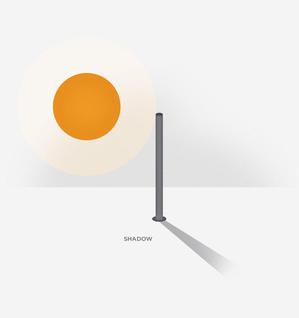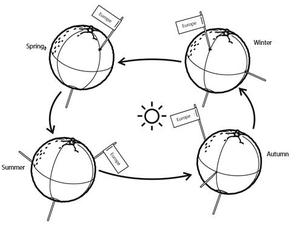Glossarbegriffe: Jahreszeiten
Description: Die Erdachse steht nicht senkrecht zur Erdumlaufbahn um die Sonne, sondern ist in einem Winkel von 23,4 Grad zu ihr geneigt. Infolgedessen verändert sich die scheinbare Position der Sonne am Himmel zu einer bestimmten Tageszeit im Laufe des Jahres. Wenn die Sonne - im Durchschnitt - höher am Himmel steht, erreicht mehr Sonnenlicht einen bestimmten Bereich der Erdoberfläche. Das führt im Laufe des Jahres zu wärmeren und kälteren Zeitabschnitten, die in Regionen, die weiter vom Äquator entfernt sind, stärker ausgeprägt sind und als Jahreszeiten bezeichnet werden. Die Jahreszeiten der nördlichen Hemisphäre sind den südlichen Jahreszeiten entgegengesetzt: Der Sommer auf der Nordhalbkugel, d.h. die drei Monate um den 21. Juni, in denen die Nordhalbkugel der Sonne am stärksten zugewandt ist, entspricht dem Winter auf der Südhalbkugel, bei dem die Südhalbkugel von der Sonne abgewandt ist. Das Gleiche gilt für den Sommer auf der südlichen Hemisphäre und den Winter auf der nördlichen Hemisphäre, also die drei Monate um den 21. Dezember. In vielen Teilen der Erde in Äquatornähe gibt es Jahreszeiten, die sich von den Sommer- und Wintermustern in den gemäßigten und arktischen Breitengraden unterscheiden. Es kann von kulturellen Gepflogenheiten und dem Zeitalter abhängen, wie die Dauer, der Beginn und das Ende der einzelnen Jahreszeiten festgelegt sind.
Zugehörige Glossarbegriffe:
See this term in other languages
Term and definition status: The original definition of this term in English have been approved by a research astronomer and a teacher The translation of this term and its definition is still awaiting approval
The OAE Multilingual Glossary is a project of the IAU Office of Astronomy for Education (OAE) in collaboration with the IAU Office of Astronomy Outreach (OAO). The terms and definitions were chosen, written and reviewed by a collective effort from the OAE, the OAE Centers and Nodes, the OAE National Astronomy Education Coordinators (NAECs) and other volunteers. You can find a full list of credits here. All glossary terms and their definitions are released under a Creative Commons CC BY-4.0 license and should be credited to "IAU OAE".
If you notice a factual or translation error in this glossary term or definition then please get in touch.
Related Activities
Sun’s Shadow
astroEDU educational activity (links to astroEDU website) Description: Why is the Sun's shadow so important?
License: CC-BY-4.0 Creative Commons Namensnennung 4.0 International (CC BY 4.0) icons
Tags:
Hands-on
, Shadows
Age Ranges:
6-8
, 8-10
, 10-12
, 12-14
, 14-16
Education Level:
Informal
, Middle School
, Primary
, Secondary
Areas of Learning:
Observation based
, Social Research
Costs:
Medium Cost
Duration:
1 day
Group Size:
Group
Skills:
Asking questions
, Communicating information
, Constructing explanations
, Engaging in argument from evidence
Seasons Around the World
astroEDU educational activity (links to astroEDU website) Description: Demonstrate the seasons on Earth using a model.
License: CC-BY-4.0 Creative Commons Namensnennung 4.0 International (CC BY 4.0) icons
Tags:
Hands-on
, Model
Age Ranges:
6-8
, 8-10
, 10-12
Education Level:
Middle School
, Primary
Areas of Learning:
Modelling
, Social Research
Costs:
Medium Cost
Duration:
45 mins
Group Size:
Group
Skills:
Analysing and interpreting data
, Asking questions
, Constructing explanations
, Developing and using models
, Planning and carrying out investigations
Navigate like a Viking – Use the Sun, not your phone!
astroEDU educational activity (links to astroEDU website) Description: Learn how the Vikings used the sky to navigate at sea with a hands-on activity!
License: CC-BY-4.0 Creative Commons Namensnennung 4.0 International (CC BY 4.0) icons
Tags:
History
, Geography
, Maps
, Coordinates
, Celestial navigation
Age Ranges:
12-14
, 14-16
Education Level:
Middle School
Areas of Learning:
Discussion Groups
, Modelling
, Social Research
Costs:
Medium Cost
Duration:
1 hour 30 mins
Group Size:
Group
Skills:
Analysing and interpreting data
, Asking questions
, Communicating information
, Developing and using models
, Planning and carrying out investigations
, Using mathematics and computational thinking











